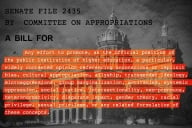You have /5 articles left.
Sign up for a free account or log in.
Last week, a federal court in Boston issued a powerful and comprehensive decision affirming Harvard University’s right to admit a diverse student body through the consideration of race in admissions. I served as Harvard’s general counsel until July 2019 and applaud the court’s decision.
It can be rare to find consensus on any issue in higher education, but the case against Harvard touched on a central and broadly shared belief: the quality of the education we offer our students is improved by admitting a diverse student body. Through that diversity, we allow our students to see the world through eyes other than their own and encourage them to question their settled assumptions. We open up new fields of inquiry and new perspectives on existing fields. We assure that the next generation of society’s leaders will be drawn from the full richness of American society.
Had the plaintiff in the case against Harvard succeeded, those benefits would have been compromised, as access to higher education would have been sharply restricted for talented students from groups far too long underrepresented on our campuses. The district court understood that the law did not give the plaintiff the means to bring about such a profound and societally consequential outcome.
The court’s decision matters on another dimension. That dimension was not litigated in the courtroom, but its importance has become even clearer in the five years since the complaint was filed: the capacity of members of society to reach across divides and find common ground.
On July 1, I assumed the presidency of Gettysburg College, and just several weeks ago, I gave my inaugural address. My remarks focused on the lessons the distinctive history of Gettysburg continues to offer our nation. Through the three-day battle fought in and around my campus -- the bloodiest battle ever waged on American soil -- we see vividly what happens when society loses the tools that permit us to reach across difference. It was a lesson Abraham Lincoln understood and expressed in his timeless remarks at the National Cemetery. In an address at Gettysburg College in 1946, Dwight Eisenhower recognized that Lincoln saw the necessity of uniting “faction and section, and section and party, to eliminate prejudice and bitterness and hate and to establish a peace assuring eternal union.”
Given the polarization that exists in society today, we, too, have a compelling need to find people who can “unite faction and section,” transcend difference, and defuse partisanship. Where, if not on college and university campuses, will citizens learn such skills? We live in increasingly segregated communities and increasingly listen only to those whose life experiences mirror our own. If we don’t expose students to diversity on our campuses, if they do not learn how to navigate difference in places like Gettysburg and Harvard, when will they do so? If our students do not develop those skills, who will? Who will help close the divides and bridge the misunderstandings and suspicions that so heavily define our current discourse?
Although the court’s opinion represents a clear and important victory for higher education, there are lessons to be learned and cautions to be heeded. Experience on college and university campuses demonstrates that a diverse student body benefits all students, from all races and backgrounds, by creating the sort of vibrant educational environment where the fullest range of perspectives are present on campus. Yet the plaintiff sought to frame the case as a zero-sum game, one where some groups win at the expense of other groups, and especially at the expense of Asian American students.
That approach by the plaintiff was quite deliberate. The person who played an instrumental role in the repeated challenges to the admissions process at the University of Texas -- a case that twice went before the United States Supreme Court -- formed and guided the organization behind the suit. At the Harvard trial, it was shown that when the effort against Texas failed, brought in the name of a white woman, the plaintiff sought to reframe the issue as one of discrimination against Asian Americans. It is hard not to conclude that, by doing so, the plaintiff was hoping to generate sympathy for its ultimate objective: the elimination of any form of race-conscious admissions.
Although the plaintiff’s organization sought to cast itself as vindicating the interests of Asian American students, its approach at trial is worth noting. The plaintiff called no Asian American applicant or student, indeed, for that matter, no student at all. It unsuccessfully opposed the request to testify by student amici, including students from Asian American backgrounds. When those students ultimately did testify at trial, they recounted their own experiences and brought vividly to life the transformation made possible by a diverse student body.
The plaintiff’s approach may not have succeeded before the district court, but it did raise understandable concerns within the Asian American community and others rightly committed to ensuring that the admission processes at America’s best colleges and universities are fair. Ultimately, the national conversation the Harvard suit sparked has made clear that we in higher education have work to do to explain better not just the goals we seek to achieve through a diverse student body but also the means by which we advance those goals. The court’s decision does not render that work moot.
The Harvard decision may well be the first step in protracted litigation before the higher courts. If so, we can be certain that the plaintiff will continue to fight in the court of public opinion. Higher education needs to be prepared to do so as well.








